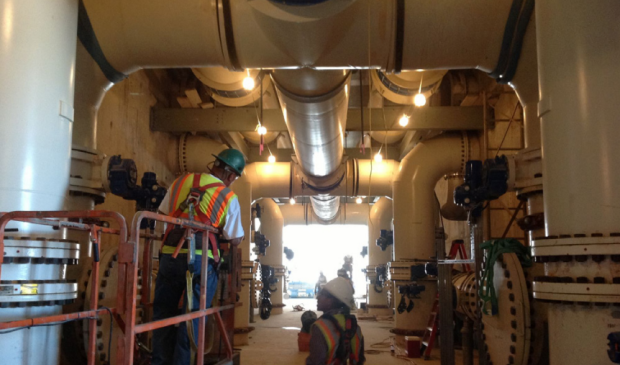Council to consider settling with WTP 4 contractors
Thursday, June 18, 2015 by
Jo Clifton After years of public discussion and argument, the city built Water Treatment Plant 4 and it began operating six months ago with little fanfare. There is just one piece of business remaining for completion of the plant and its financing. City Council will consider today whether to settle a claim with the construction manager at risk, MWH Constructors, Inc., and subcontractors Southland/Mole Joint Venture, Laughlin Thyssen, and STR Constructors.
Working with a mediator, staff has negotiated a settlement for approximately $4.6 million over claims for startup costs that MWH says it incurred outside the scope of the contract with the city as well as claims from the three primary subcontractors.
If Council approves the settlement, the final cost of the plant will be $528.1 million, according to Austin Water Utility Assistant Director David Anders. The original Council appropriation for the project was $508 million in 2007 or 2008, he said. Then in 2012, Council added $15.5 million for a transmission main, bringing the total to $523.5 million. Add this $4.6 million amendment, and the total rises to $528.1 million.
Howard Lazarus, director of the Public Works Department, told Council in a memo that the $4,644,753 settlement represents a $10 million reduction from the claims presented by the prime contractor and subcontractors at the end of the last mediation session. At that point, he said, MWH and the subcontractors were seeking $14 million beyond the current contract.
In his memo, Lazarus explained that the settlement is “an opportunity to settle all outstanding disputes on this project.”
If approved, the utility will sell commercial paper to fund the settlement and the utility’s capital budget will be increased by that amount.
Anders explained that the city is “financing all of WTP 4, including this additional $4.6 million, primarily through the issuance of commercial paper as an interim financing mechanism.”
That commercial paper will be outstanding for about a year to 18 months, Anders said, and then the city will issue long-term revenue bonds to pay off the paper.
At this point, he continued, it is much cheaper for the city to issue the commercial paper than the revenue bonds because the city will only have to pay about one-half percent interest on the paper. All of this financing is part of the utility’s long-term debt-financing plan, which is paid for through customers’ utility bills.
Anders stressed that the commercial paper, because it is so cheap, will have no impact on utility rates. He added that the cost of financing the extra $4.6 million would be less than $400,000 a year.
Lazarus reports that since the plant was completed, it has treated and delivered more than 3.8 billion gallons of water “and provided the Austin Water Utility with the ability to draw water from Lake Travis, the deepest and highest quality water source in the Highland Lakes chain.
“The plant has achieved all of the design goals, improved responsiveness to an unexpected water system disruption (and) allowed AWU to implement short-term shutdowns of aging infrastructure assets — such as the Davis Water Plant — in order to perform much-needed repairs and improvements to these facilities.”
Environmentalists had many objections to WTP4; however, Lazarus wrote, “(t)he project was completed in an environmentally sensitive area with no incidents, with an exceptional safety record, and a seamless commissioning and startup process.”
Photo courtesy of the City of Austin.
You're a community leader
And we’re honored you look to us for serious, in-depth news. You know a strong community needs local and dedicated watchdog reporting. We’re here for you and that won’t change. Now will you take the powerful next step and support our nonprofit news organization?








